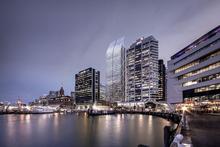Apr 20, 2015

Private and public projects on Auckland’s drawing board have cracked the $10 billion mark. Auckland Council’s City Centre Integration team has just released a map showing the huge public and private investment planned for the next decade.
But many of the projects are not funded in the 10-year budget and are simply plans.
The map showed 48 council projects but interestingly did not show controversial extensions to Bledisloe Wharf or the creation of a new cruise ship terminal at Captain Cook Wharf.
Major council projects mapped include the Albert St upgrade, new bus infrastructure, the Ferry Basin redevelopment, Headland Park planned for the end of the Wynyard Point and the upgrade of Te Wero Bridge.
Huge new private sector apartment and hotel plans, including those around the Wynyard Quarter, are also plotted.
A team spokesman said more than 3000 new apartments were in the consenting process and more were in the pipeline.
“Office vacancy rates are at record lows so many new developments are set to unlock further growth and create the space for many thousands of new jobs,” he said.
Matt Lowrie, transport advocate and Transportblog editor, said people did not realise the scale of change planned. “People love the changes over the last five years with the likes of Wynyard, Britomart and shared spaces and this shows benefits will be coming to many more areas of the city. That will only help in making Auckland more attractive and liveable, improve the economy and therefore be able to complete better globally for business and talent,” he said.
But Auckland councillor Cameron Brewer said the CBD obsession was to the detriment of Auckland’s 100 villages and town centres, now falling into disrepair.
Only about 12 per cent of Aucklanders worked in the CBD yet the small area was where most of the money was being sunk, particularly with the $2.5 billion City Rail Link.
“Instead of cutting funding to community projects, town centres, library hours and parks maintenance, I’d rather see the knife wielded at the CCOs and the CBD, that’s where there’s still plenty of fat to be found,” he said.
“The public were promised that any money raised by an interim transport targeted rate, tolling or a fuel tax would be going towards providing essential intergenerational infrastructure projects that would help drive Auckland’s economic growth.
“Now we learn that tolls will fund things like beautifying and pedestrianising Quay St and even the Quay St seawall upgrade. That will not impress Auckland drivers when the mayor has promised that extra and alternative revenue raised will go towards more roads and better public transport,” Brewer said.
The team spokesman said no new CBD tower had been built this decade but several are being planned.
Those include Precinct Properties’ 35-level $550 million Downtown Development project announced earlier this year.
“Albert St alone is set for a major makeover. Digging up the street for the City Rail Link provides an opportunity to reinstate it in a much more attractive state, and concept images just released show what could be achieved.
Meanwhile, new private developments along its length are to take advantage of the street improvements, meaning the Albert St of 2025 may be barely recognisable from the one that exists now,” he said.
“The council family’s focus in the centre is twofold: making it a great place for people to live, work, study, visit, enjoy events and – importantly – for businesses to invest; and on delivering the transport improvements that provide efficient access and that enable as many Aucklanders as possible to connect to it and benefit from the jobs and opportunities it offers,” he said.
“New Zealand needs its biggest centre to perform well. The concentration of industries is an important balance for the rest of the country and for the creation of a more resilient and diverse economy.
“At the same time, these changes signal Auckland’s emergence from a small city on the world stage to one that is becoming recognised as one of the world’s most liveable mid-sized cities. It is now mentioned alongside Melbourne, Seattle, Sydney … cities that it used to just look up to.
“Already more people commute by public transport into the city than drive, and last month saw rail passenger numbers surpass 1.5 million trips – an increase of 29 per cent on March last year.”
